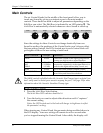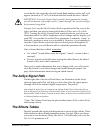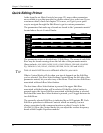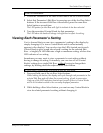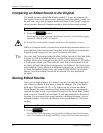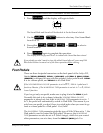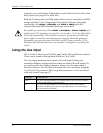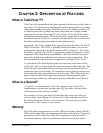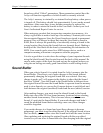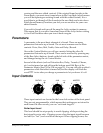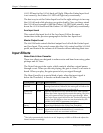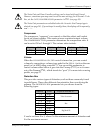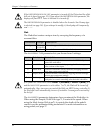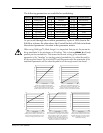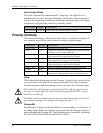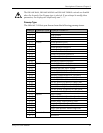
Chapter 3: Description of Features
20 AxSys 212 User Manual
Sound are called ÒGlobalÓ parameters. These parameters control how the
AxSys will function regardless of which Sound is currently selected.
The AxSysÕ memory is retained by an internal backup battery when power
is turned off. This battery should last approximately 5 years under normal
conditions. After some time, it may become necessary to replace this
battery in order to retain the Sounds in the User Bank. Contact your local
Line 6 Authorized Repair Center for service.
When using any product that incorporates computer-type memory, it is
always a good idea to make a back-up of its memoryÕs contents just in case
the unexpected happens. Since the Preset Sounds are stored in permanent
memory, they will always be there. But since the User Bank is stored in
RAM, there is always the possibility of accidentally storing a Sound in the
wrong location (thus losing the Sound that was formerly there). Making a
backup of the User Bank can be done by transmitting the information via
MIDI. Your sounds can be stored to a MIDI storage device, such as a
computer running a librarian or sequencer software program.
It is also a good idea to write down the settings of your important Sounds
using the blank Sound Chart located towards the back of this manual. Be
sure to make copies of the chart first and not use the original (unless you
only plan on having one really good Sound thatÕs worth writing down).
Sound Buffer
When you select a Sound, it is copied from the AxSysÕ memory into the
Sound Buffer. This allows you to make changes to the Sound without
permanently changing the original Sound that was selected. Once any
change is made, an E will appear in the display to show that the Sound
has been ÒEditedÓ. Now the Sound in the Sound Buffer is different from
the original Sound. Because the Sound Buffer is separate from the memory
used to store Sounds, we can use the Compare feature to switch back and
forth between the original (unedited) Sound and the new (edited) version.
After making changes, you must store the altered Sound in the Sound
Buffer into one of the 128 User Sound memory locations
before selecting
another Sound from memory. This is because when you select a new
Sound, itÕs put into the Sound Buffer. If you made changes and hadn't
saved the modified Sound before selecting a new one, those changes
would be forgotten.
If you make changes to a Sound and want those changes to become
permanent, you
must store the edited Sound. If the original Sound is from
the User Bank, you can either store this Sound back into the same location
(thus updating and replacing the original Sound with the new edited
version) or you can store it somewhere else (thus keeping both the original



